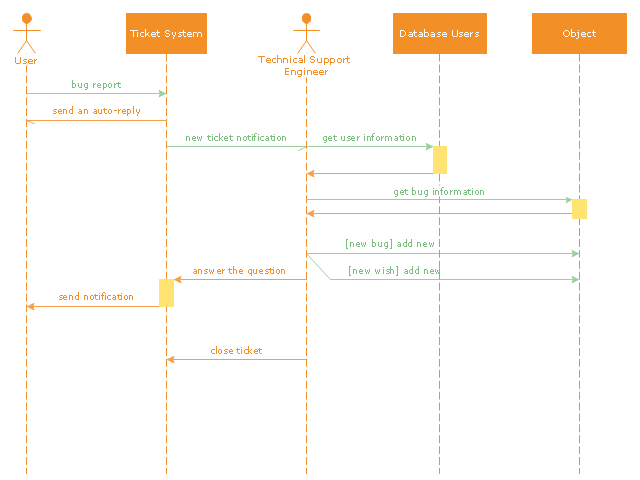"An example scenario is presented to demonstrate how a common issue tracking system would work:
(1) A customer service technician receives a telephone call, email, or other communication from a customer about a problem. Some applications provide built-in messaging system and automatic error reporting from exception handling blocks.
(2) The technician verifies that the problem is real, and not just perceived. The technician will also ensure that enough information about the problem is obtained from the customer. This information generally includes the environment of the customer, when and how the issue occurs, and all other relevant circumstances.
(3) The technician creates the issue in the system, entering all relevant data, as provided by the customer.
(4) As work is done on that issue, the system is updated with new data by the technician. Any attempt at fixing the problem should be noted in the issue system. Ticket status most likely will be changed from open to pending.
(5) After the issue has been fully addressed, it is marked as resolved in the issue tracking system.
If the problem is not fully resolved, the ticket will be reopened once the technician receives new information from the customer. A Run Book Automation process that implements best practices for these workflows and increases IT personnel effectiveness is becoming very common." [Issue tracking system. Wikipedia]
The UML sequence diagram example "Ticket processing system" was created using the ConceptDraw PRO diagramming and vector drawing software extended with the Rapid UML solution from the Software Development area of ConceptDraw Solution Park.
(1) A customer service technician receives a telephone call, email, or other communication from a customer about a problem. Some applications provide built-in messaging system and automatic error reporting from exception handling blocks.
(2) The technician verifies that the problem is real, and not just perceived. The technician will also ensure that enough information about the problem is obtained from the customer. This information generally includes the environment of the customer, when and how the issue occurs, and all other relevant circumstances.
(3) The technician creates the issue in the system, entering all relevant data, as provided by the customer.
(4) As work is done on that issue, the system is updated with new data by the technician. Any attempt at fixing the problem should be noted in the issue system. Ticket status most likely will be changed from open to pending.
(5) After the issue has been fully addressed, it is marked as resolved in the issue tracking system.
If the problem is not fully resolved, the ticket will be reopened once the technician receives new information from the customer. A Run Book Automation process that implements best practices for these workflows and increases IT personnel effectiveness is becoming very common." [Issue tracking system. Wikipedia]
The UML sequence diagram example "Ticket processing system" was created using the ConceptDraw PRO diagramming and vector drawing software extended with the Rapid UML solution from the Software Development area of ConceptDraw Solution Park.
- UML use case diagram - Ticket processing system | UML ...
- UML sequence diagram - Ticket processing system | UML sequence ...
- UML Sequence Diagram Example. SVG Vectored UML Diagrams ...
- UML Sequence Diagram
- Diagramming Software for designing UML Sequence Diagrams ...
- Sequence Diagram Tool | UML Sequence Diagram . Design ...
- Messages - Vector stencils library | UML Sequence Diagram . Design ...
- UML sequence diagram - Template
- UML Sequence Diagram | Diagramming Software for designing ...
- Diagramming Software for designing UML Sequence Diagrams ...
- Sequence Diagram For Book Issue Process Of Library
- Uml Sequence Diagram Lifeline
- UML sequence diagram - Ticket processing system | UML Diagram ...
- UML use case diagram - Trading system usage scenarios | UML ...
- What Is A Sequence Diagram
- UML Sequence Diagram . Design Elements
- UML sequence diagram - Ticket processing system | PM ...
- Data Flow Diagram | UML sequence diagram - Ticket processing ...
- Trouble ticket system - BPMN 2.0 diagram | UML sequence diagram ...
